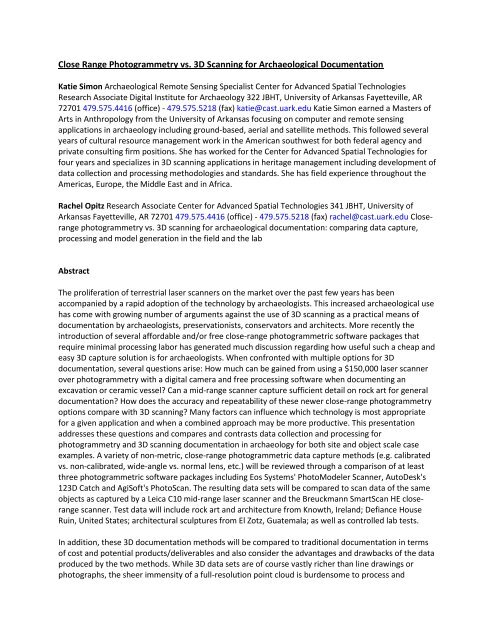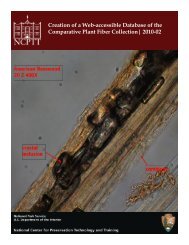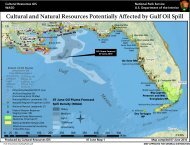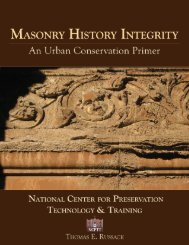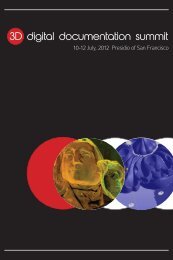Close Range Photogrammetry vs. 3D Scanning for Archaeological ...
Close Range Photogrammetry vs. 3D Scanning for Archaeological ...
Close Range Photogrammetry vs. 3D Scanning for Archaeological ...
Create successful ePaper yourself
Turn your PDF publications into a flip-book with our unique Google optimized e-Paper software.
<strong>Close</strong> <strong>Range</strong> <strong>Photogrammetry</strong> <strong>vs</strong>. <strong>3D</strong> <strong>Scanning</strong> <strong>for</strong> <strong>Archaeological</strong> Documentation<br />
Katie Simon <strong>Archaeological</strong> Remote Sensing Specialist Center <strong>for</strong> Advanced Spatial Technologies<br />
Research Associate Digital Institute <strong>for</strong> Archaeology 322 JBHT, University of Arkansas Fayetteville, AR<br />
72701 479.575.4416 (office) - 479.575.5218 (fax) katie@cast.uark.edu Katie Simon earned a Masters of<br />
Arts in Anthropology from the University of Arkansas focusing on computer and remote sensing<br />
applications in archaeology including ground-based, aerial and satellite methods. This followed several<br />
years of cultural resource management work in the American southwest <strong>for</strong> both federal agency and<br />
private consulting firm positions. She has worked <strong>for</strong> the Center <strong>for</strong> Advanced Spatial Technologies <strong>for</strong><br />
four years and specializes in <strong>3D</strong> scanning applications in heritage management including development of<br />
data collection and processing methodologies and standards. She has field experience throughout the<br />
Americas, Europe, the Middle East and in Africa.<br />
Rachel Opitz Research Associate Center <strong>for</strong> Advanced Spatial Technologies 341 JBHT, University of<br />
Arkansas Fayetteville, AR 72701 479.575.4416 (office) - 479.575.5218 (fax) rachel@cast.uark.edu <strong>Close</strong>range<br />
photogrammetry <strong>vs</strong>. <strong>3D</strong> scanning <strong>for</strong> archaeological documentation: comparing data capture,<br />
processing and model generation in the field and the lab<br />
Abstract<br />
The proliferation of terrestrial laser scanners on the market over the past few years has been<br />
accompanied by a rapid adoption of the technology by archaeologists. This increased archaeological use<br />
has come with growing number of arguments against the use of <strong>3D</strong> scanning as a practical means of<br />
documentation by archaeologists, preservationists, conservators and architects. More recently the<br />
introduction of several af<strong>for</strong>dable and/or free close-range photogrammetric software packages that<br />
require minimal processing labor has generated much discussion regarding how useful such a cheap and<br />
easy <strong>3D</strong> capture solution is <strong>for</strong> archaeologists. When confronted with multiple options <strong>for</strong> <strong>3D</strong><br />
documentation, several questions arise: How much can be gained from using a $150,000 laser scanner<br />
over photogrammetry with a digital camera and free processing software when documenting an<br />
excavation or ceramic vessel? Can a mid-range scanner capture sufficient detail on rock art <strong>for</strong> general<br />
documentation? How does the accuracy and repeatability of these newer close-range photogrammetry<br />
options compare with <strong>3D</strong> scanning? Many factors can influence which technology is most appropriate<br />
<strong>for</strong> a given application and when a combined approach may be more productive. This presentation<br />
addresses these questions and compares and contrasts data collection and processing <strong>for</strong><br />
photogrammetry and <strong>3D</strong> scanning documentation in archaeology <strong>for</strong> both site and object scale case<br />
examples. A variety of non-metric, close-range photogrammetric data capture methods (e.g. calibrated<br />
<strong>vs</strong>. non-calibrated, wide-angle <strong>vs</strong>. normal lens, etc.) will be reviewed through a comparison of at least<br />
three photogrammetric software packages including Eos Systems' PhotoModeler Scanner, AutoDesk's<br />
12<strong>3D</strong> Catch and AgiSoft's PhotoScan. The resulting data sets will be compared to scan data of the same<br />
objects as captured by a Leica C10 mid-range laser scanner and the Breuckmann SmartScan HE closerange<br />
scanner. Test data will include rock art and architecture from Knowth, Ireland; Defiance House<br />
Ruin, United States; architectural sculptures from El Zotz, Guatemala; as well as controlled lab tests.<br />
In addition, these <strong>3D</strong> documentation methods will be compared to traditional documentation in terms<br />
of cost and potential products/deliverables and also consider the advantages and drawbacks of the data<br />
produced by the two methods. While <strong>3D</strong> data sets are of course vastly richer than line drawings or<br />
photographs, the sheer immensity of a full-resolution point cloud is burdensome to process and
manipulate, and includes extraneous in<strong>for</strong>mation which can obscure, rather than clarify, the most<br />
important features in a line drawing. Thus, vector extraction techniques <strong>for</strong> the rapid creation of digital<br />
line drawings from large point clouds will be discussed. We will close with a summary of <strong>3D</strong> scanning<br />
and photogrammetry metadata standards as developed by the Center <strong>for</strong> Advanced Spatial<br />
Technologies <strong>for</strong> the Digital <strong>Archaeological</strong> Record (tDAR) and the <strong>Archaeological</strong> Data Service (ADS).<br />
Thank you, Katie --


